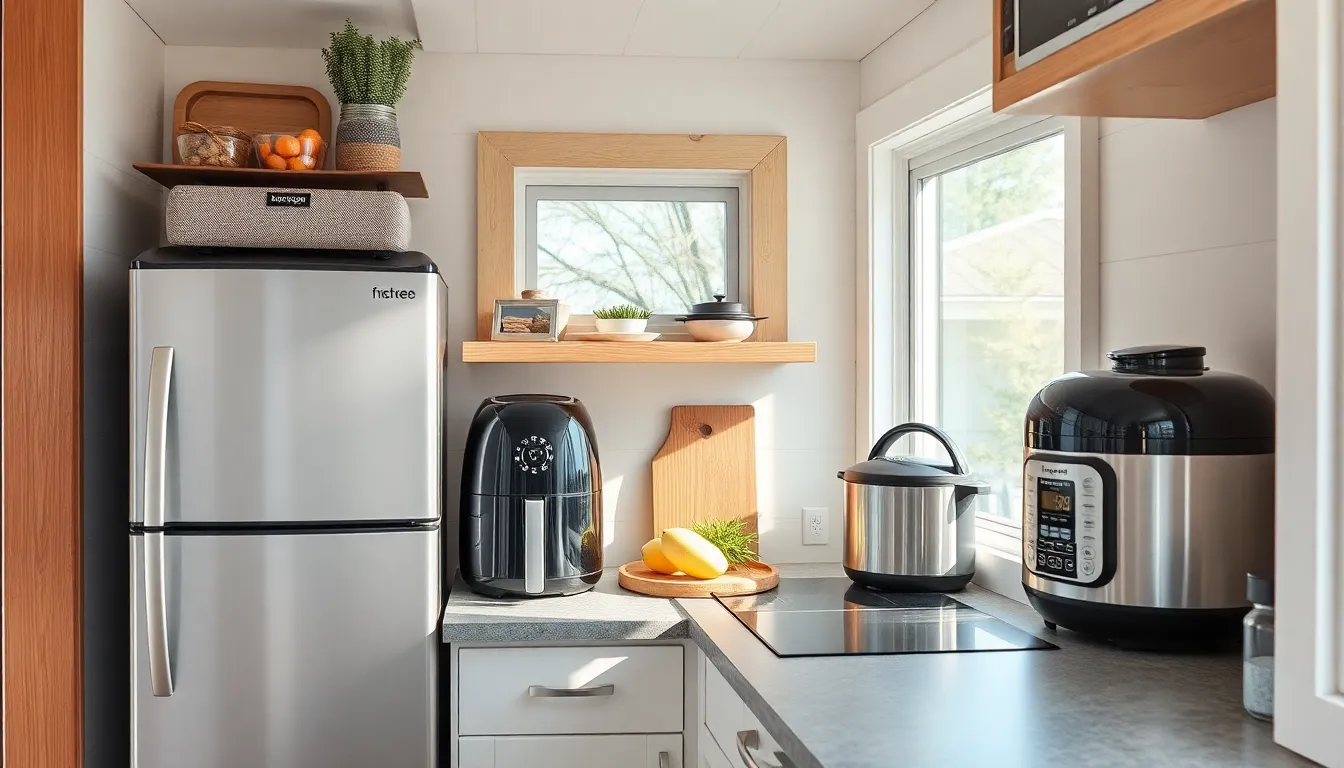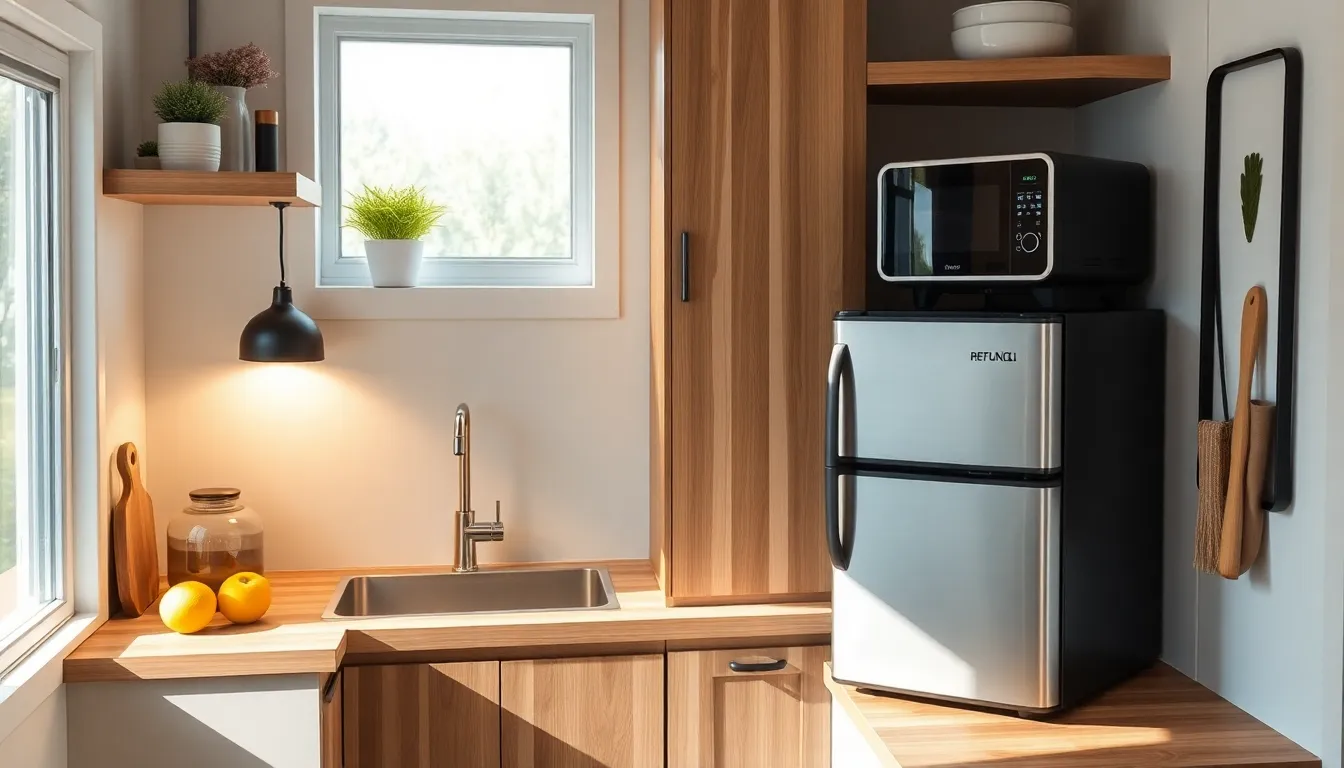
Tiny Home Appliances: Maximize Space and Functionality in Your Kitchen
In a world where bigger often seems better, tiny home appliances are here to prove that good things really do come in small packages. These pint-sized powerhouses pack a punch, making them perfect for anyone looking to maximize space without sacrificing functionality. Imagine whipping up a gourmet meal in a kitchen that feels more like a closet than a culinary haven.
Tiny Home Appliances
Tiny home appliances are essential for efficient living in small spaces. These devices provide versatility without sacrificing kitchen functionality. Compact refrigerators, for example, offer ample storage while fitting into tight corners. Induction cooktops serve as a powerful alternative to traditional stoves, heating quickly and safely.
Microwave ovens fit snugly on countertops, making meal preparation faster. Many blenders blend smoothies and soups, even in limited square footage. Coffee makers cater to caffeine lovers, ensuring they enjoy their brews without cluttering their countertops. Toasters and toaster ovens provide quick breakfast solutions, making mornings more manageable.
Options also include multi-cookers, which combine several cooking methods into one appliance. Air fryers offer healthier cooking alternatives by reducing oil usage. Dishwashers, designed for tiny homes, perform efficiently, saving time on clean-up while conserving water.
Users appreciate the space-saving design of these appliances. This design often features compact dimensions and lightweight materials. Additionally, many models are energy-efficient, lowering utility bills. The technology behind these devices continually improves, offering enhanced features that meet modern needs.
Market demand grows as people embrace tiny living. Products are evolving to cater to this trend, providing quality and convenience. Consumers find a vast selection of brands and styles, ensuring options that suit personal preferences. With proper care, tiny home appliances last long and contribute significantly to a functional living space.
Benefits of Using Tiny Home Appliances

Tiny home appliances offer several advantages, specifically addressing the needs of compact living spaces. Their unique features enhance functionality while maximizing efficiency.
Space Efficiency
Tiny home appliances excel in space efficiency. Each device is specifically designed to occupy minimal countertop and storage area. Compact refrigerators and microwave ovens provide essential functions without overwhelming the available space. Multi-cookers and air fryers combine multiple cooking functions into one unit, reducing clutter. Lightweight materials and sleek designs enable easy placement in confined areas. This optimization of space allows users to enjoy full kitchen capabilities without sacrificing comfort. Additionally, smaller appliances often fit into corners or under cabinets, making the most of every inch.
Energy Conservation
Energy conservation becomes a significant benefit with tiny home appliances. Many devices are engineered with energy-efficient technology, which lessens power consumption. Compact models often require less electricity compared to standard-sized counterparts, contributing to lower utility bills. Induction cooktops, for example, heat more efficiently than traditional stoves, reducing energy waste. Since appliances operate within smaller spaces, they often heat up and cool down quickly, enhancing energy savings. Smaller power requirements support sustainable living practices while maintaining optimal performance in the kitchen.
Popular Tiny Home Appliances
Tiny home appliances combine functionality with compact designs. These devices suit the needs of modern living spaces, providing essential features in smaller forms.
Compact Refrigerators
Compact refrigerators save space while offering sufficient food storage. These appliances range in size from 1.7 to 4.5 cubic feet, making them perfect for tiny kitchens. Energy efficiency plays a crucial role in their design, with many models using less than 240 kWh annually. Features often include adjustable shelves, separate freezer compartments, and even internal lighting for easy access. Various brands offer different styles, ensuring compatibility with any decor. These refrigerators enable users to keep perishables fresh without consuming excessive space, making them a staple in tiny homes.
Multi-Functional Cookware
Multi-functional cookware enhances cooking capabilities while minimizing clutter. These versatile appliances, including instant pots, slow cookers, and air fryers, consolidate multiple cooking functions into one device. Users can pressure cook, steam, sauté, or even make yogurt, catering to diverse culinary preferences. Models typically feature programmable settings, allowing precise temperature and timing adjustments. Popular brands create durable, non-stick surfaces that facilitate easy cleaning. Space-saving designs focus on efficient storage, often fitting neatly within cabinets. Multi-functional cookware empowers tiny home residents to expand their meal options without overwhelming their kitchens.
Selecting the Right Tiny Home Appliances
Choosing the right tiny home appliances involves careful consideration of various factors. Factors such as budget, size, and functionality significantly influence the selection process.
Budget Considerations
Budget plays a crucial role when selecting tiny home appliances. Start by determining a realistic budget based on income and financial priorities. Many compact appliances cost between $50 to $500, depending on the brand and features. It’s important to balance between affordability and durability, ensuring the appliance lasts over time. Researching customer reviews can provide insights into both performance and longevity. Additionally, consider energy-efficient options that may have higher upfront costs but save on utility bills. Utilizing price comparison websites helps in finding the best deals.
Size and Functionality
Size and functionality directly impact the appliance’s efficiency in a tiny home. Measuring available countertop space ensures the appliance fits without overcrowding. Compact refrigerators, often between 1.7 to 4.5 cubic feet, maximize storage while maintaining form. Evaluating functionality is equally essential; look for appliances that combine multiple features. For instance, multi-cookers can pressure cook, steam, and sauté in one device. Prioritizing dual-purpose appliances enhances kitchen capabilities without occupying unnecessary space. Exploring vertical designs or collapsible features can further optimize storage and usability.
Maintenance Tips for Tiny Home Appliances
Regular maintenance ensures tiny home appliances perform optimally and last longer. Start by cleaning the exterior surfaces of each device with a damp cloth. Wipe down stainless steel surfaces, as they can be prone to fingerprints and stains.
Check the cleaning requirements for each appliance. For instance, descaling coffee makers every few months prevents mineral buildup that affects performance. Lint traps in small dryers or air fryers should also get cleaned routinely to maintain airflow and efficiency.
Follow the manufacturer’s guidelines for replacing filters. Most compact refrigerators come equipped with air filters that require replacement every six months. Keeping air filters updated contributes to proper airflow and energy efficiency.
Inspect appliances for leaks or wear. For multi-cookers, ensure seals remain intact to prevent steam loss during cooking. Addressing worn or damaged parts promptly keeps devices functioning effectively and prevents further issues.
Monitor energy consumption. Many tiny home appliances display energy usage information that helps identify efficiency levels. If an appliance operates poorly, it often leads to higher energy bills, signaling maintenance may be necessary.
Test batteries in cord-free appliances. Ensure items like handheld mixers or blenders receive regular battery replacements to avoid power interruptions. A charged battery contributes to optimal performance and enjoyable cooking experiences.
Store appliances appropriately when not in use. Keep them in dry, ventilated spaces to prevent moisture buildup. Proper storage extends the lifespan of tiny appliances significantly.
Utilize surge protectors for sensitive electronics. Using surge protectors helps safeguard against voltage spikes, protecting appliances from damage. Monitoring appliance longevity pays off with careful use and maintenance strategies.
Conclusion
Tiny home appliances are revolutionizing the way people approach cooking and living in smaller spaces. Their compact design and multifunctionality make it possible to enjoy a fully equipped kitchen without feeling cramped. As the demand for tiny living continues to rise, these appliances are becoming more diverse and accessible, catering to a wide range of preferences and needs.
With the right selection and care, tiny home appliances can enhance both efficiency and sustainability in everyday life. They not only save space but also reduce energy consumption, contributing to a more eco-friendly lifestyle. Embracing these innovative solutions allows individuals to maximize their living spaces while enjoying the comforts of modern kitchen technology.
